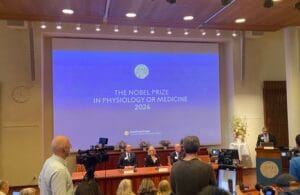The world of biology has just witnessed a significant moment with the announcement of the 2024 Nobel Prize in Physiology or Medicine. This prestigious honor has been awarded to American biologists Victor Ambros and Gary Ruvkun for their pioneering research on microRNA, a discovery that has fundamentally altered our understanding of gene regulation. Let’s explore what this means for science, medicine, and our understanding of life itself.
Understanding the Importance of the Nobel Prize
A Pinnacle of Scientific Achievement
The Nobel Prize represents the highest recognition in the field of science. Established by the will of Alfred Nobel in 1895, this award honors those who have made outstanding contributions to humanity in various fields, including medicine. Each year, the announcement generates excitement and anticipation within the scientific community and beyond.
The Role of Gene Regulation
Gene regulation is the process by which cells control the expression of genes, determining how cells differentiate into various types—like muscle, nerve, and skin cells. This process is crucial for normal development and function in multicellular organisms. Ambros and Ruvkun’s research on microRNA has shed new light on this complex regulatory mechanism.
Who Are Victor Ambros and Gary Ruvkun?
Victor Ambros: A Visionary Biologist
Ambros is a professor of natural science at the University of Massachusetts Medical School. His early work focused on the tiny roundworm Caenorhabditis elegans, a model organism that has provided insights into cellular processes applicable to more complex life forms.
Gary Ruvkun: A Genetic Pioneer
Ruvkun serves as a professor of genetics at Harvard Medical School and has also conducted research at Massachusetts General Hospital. His contributions to the field have been instrumental in advancing our understanding of microRNA and its widespread implications.
The Discovery of microRNA
What is microRNA?
MicroRNA (miRNA) is a small, non-coding RNA molecule that plays a vital role in regulating gene expression. These tiny molecules can bind to messenger RNA (mRNA) and either degrade it or inhibit its translation into proteins, effectively controlling which proteins are produced in a cell.
The Initial Discoveries
In 1993, Ambros first identified the existence of microRNA while studying C. elegans. Initially thought to be an anomaly, it took several years before its significance was recognized, particularly after Ruvkun’s discoveries expanded understanding across various species.
The Nobel Committee’s Recognition
Groundbreaking Contribution
The Nobel Prize committee hailed Ambros and Ruvkun for their “groundbreaking discovery” that revealed “an entirely new dimension to gene regulation.” Their work has laid the foundation for understanding how organisms evolve and adapt over time.
The Impact on Science and Medicine
The recognition by the Nobel committee not only celebrates their achievements but also emphasizes the ongoing importance of research in understanding genetic mechanisms. As diseases such as cancer often arise from errors in gene regulation, microRNA could be key in developing new diagnostic and therapeutic strategies.
How microRNA Regulates Gene Activity
The Mechanisms of Action
MicroRNAs exert their effects by binding to specific mRNA molecules, blocking their ability to produce proteins. This interaction is a vital part of cellular regulation, allowing cells to respond to various internal and external stimuli.
Applications in Disease Treatment
The discovery of microRNA has opened new avenues for research into treatments for diseases like cancer, where misregulation of genes can lead to uncontrolled cell growth. By targeting microRNAs, scientists hope to develop more effective therapies.
The Broader Implications of Their Work
From Worms to Humans
While their research began with a small worm, the implications extend to larger organisms, including humans. The principles discovered by Ambros and Ruvkun have influenced a vast array of fields, from developmental biology to oncology.
A Pathway to New Therapies
Current research focuses on how microRNA profiles can be utilized for personalized medicine. Understanding a patient’s unique genetic makeup can lead to tailored treatment plans, enhancing the effectiveness of therapies.
The Future of Gene Regulation Research
Anticipated Advances
With the growing interest in microRNA, scientists expect further discoveries that could transform our understanding of genetics and cell biology. Ongoing research is likely to yield new insights that can be translated into clinical applications.
The Role of Emerging Technologies
Technological advancements, such as CRISPR and high-throughput sequencing, will undoubtedly play a critical role in future research. These tools allow for precise manipulation and analysis of genetic material, paving the way for breakthroughs in gene therapy.
Celebrating Scientific Achievement
The Impact of Awards
The Nobel Prize not only honors the winners but also inspires future generations of scientists. Ambros and Ruvkun’s recognition underscores the importance of perseverance and innovation in scientific research.
What’s Next for the Laureates?
As they receive this honor, Ambros and Ruvkun are likely to continue their research, further contributing to the scientific community. Their legacy will inspire countless young scientists to pursue careers in research and discovery.
Conclusion
The 2024 Nobel Prize in Medicine awarded to Victor Ambros and Gary Ruvkun marks a significant milestone in the field of biology. Their groundbreaking work on microRNA has transformed our understanding of gene regulation, offering promising avenues for medical advancements. As we celebrate their achievements, we also look forward to the future of research that will continue to unravel the complexities of genetics and improve human health.
Also read:
Gillian Anderson’s Top Moisturisers
FAQs
1. What is microRNA and why is it important?
MicroRNA is a small RNA molecule that regulates gene expression, influencing how genes are activated in different cell types. Its discovery has profound implications for understanding development and disease.
2. How did Ambros and Ruvkun discover microRNA?
Ambros discovered the first microRNA in 1993 while studying C. elegans. Ruvkun’s subsequent work demonstrated that microRNAs are found across various species, establishing their significance in genetics.
3. What are the potential applications of microRNA research?
MicroRNA research holds potential for developing new diagnostic tools and therapies for diseases like cancer, where gene regulation plays a crucial role.
4. Why is the Nobel Prize significant in the scientific community?
The Nobel Prize is the highest honor in science, recognizing groundbreaking contributions that have a lasting impact on humanity and inspiring future generations of researchers.
5. What does this award mean for the future of gene regulation research?
This award highlights the importance of understanding gene regulation and encourages continued research, potentially leading to new insights and medical advancements in the field.



